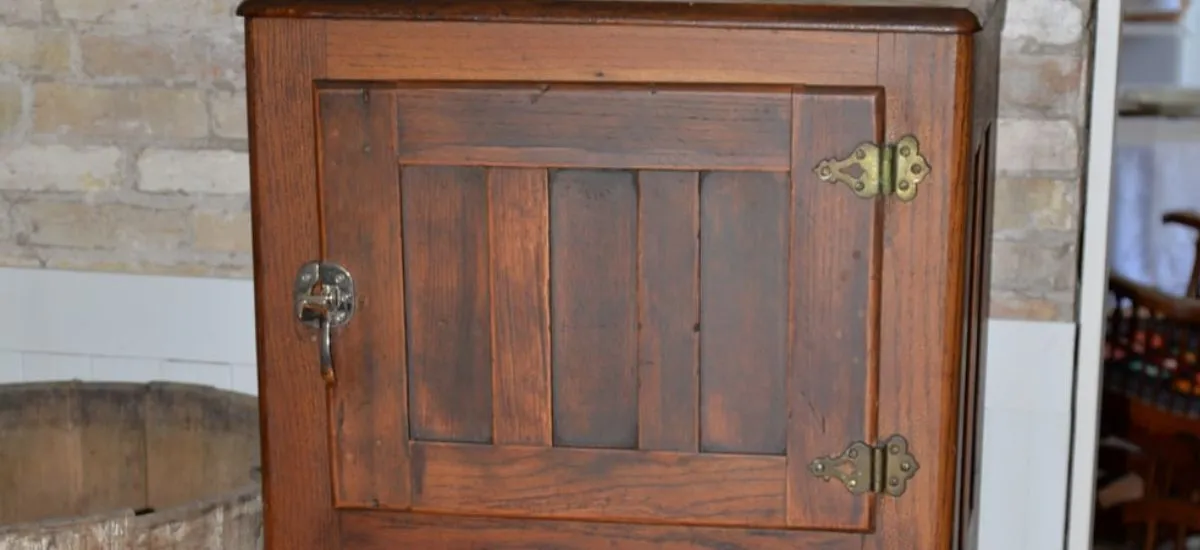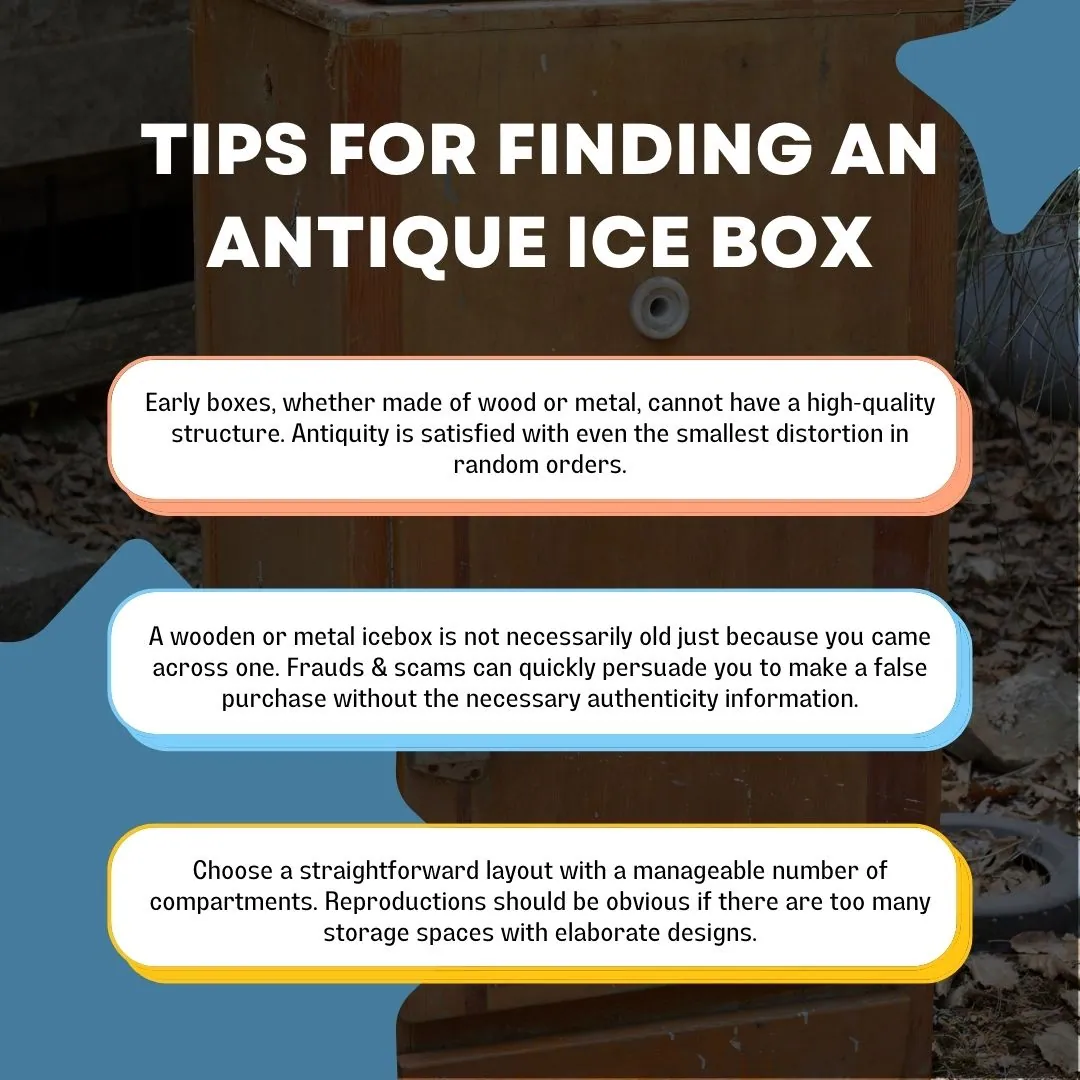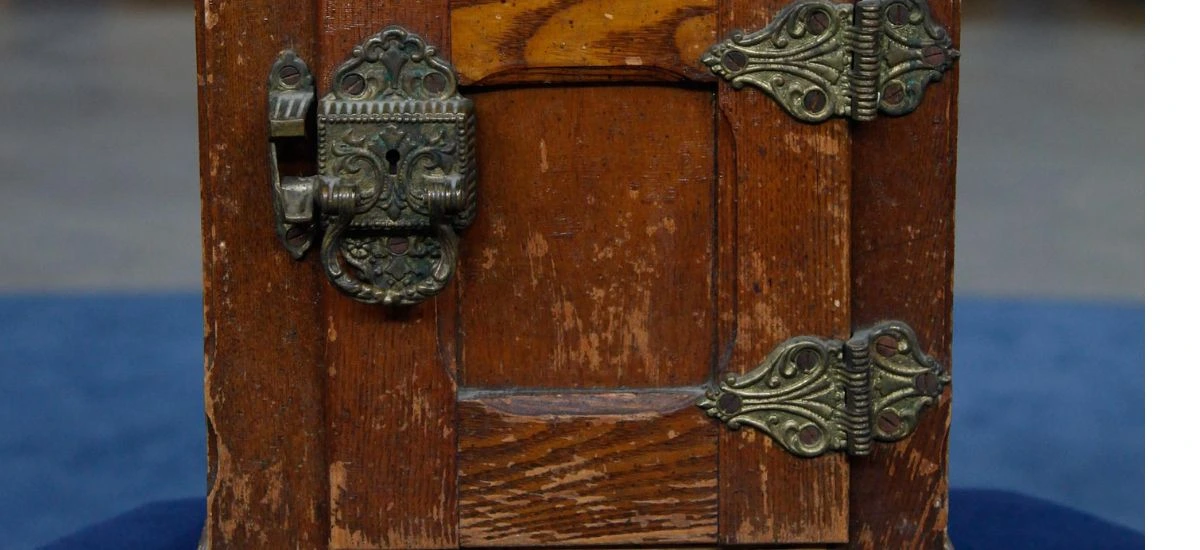Have you ever come across an original antique ice box and thought about how to date a wooden box that old or how ice boxes work? These boxes, produced by antique ice box manufacturers belonging to a bygone era, seem fascinating and can cost you a fortune.
As identifying them can be a real task, knowing what to look for to determine their age is vital. Dating an old ice box can be challenging; however, by looking for a nameplate having one of the names of antique wooden ice box manufacturers, you can estimate its manufacturing date.
In this article, we will be mentioning the process of How To Date An Antique Ice Box, how old ice boxes work, how much is an antique ice box worth, some information about icebox history, and more. We will also talk about some of the most expensive antique ice boxes, and the difference between antique wooden ice boxes and steel ice boxes.
The refrigerator and icebox are indeed the ultimate predecessors, but there were lives before them. The old furniture from a century ago kept some food and drink cold. Additionally, an antique design can raise the value of your current decor.
It can be difficult to envision modern life without a refrigerator. However, people have managed to survive without it for many years and keep food from spoiling. They used big ice blocks to keep their drinks cold and created the Ice Box in the process.
How to date an antique ice box: Professional Guide
It can be very challenging to date one of these original antique ice boxes because the function and form of antique ice boxes didn’t change all that much over the past 50 years.

Dating an antique ice box involves researching its features, materials, and construction, as well as examining any manufacturer’s marks or labels. Here are some steps to help you date an antique ice box:
Examine the materials: Antique ice boxes were typically made of wood, with interior linings made of metal or porcelain. Look for evidence of wear, such as scratches or dents, that can help you determine the age of the ice box.
Look for manufacturer’s marks: Many antique ice boxes were labeled with the manufacturer’s name, logo, or model number. Search online or consult reference books on antique ice boxes to identify the manufacturer and the date range in which they produced ice boxes.
Study the design and construction: Ice boxes varied in design and construction over time, so examining the style and construction can also help you date the ice box. For example, early ice boxes had flat tops, while later models had rounded tops. Early ice boxes had hardware that was often hand-forged, while later models had mass-produced hardware.
Research the history of the ice box: Understanding the history of the ice box can also help you determine its age. Ice boxes were commonly used in households and businesses from the mid-1800s to the mid-1900s, but the technology and design changed over time.
Consult with experts: If you are unsure about the age of an antique ice box, consult with experts, such as antique dealers or appraisers, who can help you identify the age and value of the item.
Keep in mind that dating an antique ice box can be challenging, and it may require a combination of these methods to determine the age of the ice box with greater accuracy.
Tips for finding an antique ice box

- A wooden or metal icebox is not necessarily old just because you came across one. Frauds & scams can quickly persuade you to make a false purchase without the necessary authenticity information. However, making sure of the following things before buying should protect you from replicas or fake antiques.
- Early boxes, whether made of wood or metal, cannot have a high-quality structure. Antiquity is satisfied with even the smallest distortion in random orders.
- To spot deterioration, closely inspect the wooden surface. There should be at least a few spots where visible cracks, chips, scratches, and warps are present.
- Choose a straightforward layout with a manageable number of compartments. Reproductions should be obvious if there are too many storage spaces with elaborate designs.
- Pay close attention to the corners for any deviations from the norm in accuracy. Significant indications of vintage wood pieces may be found in the finishing on the edges.
- Look for specific indications of traditional craftsmanship in the joinery. Bolts, nuts, screws, and other fasteners must have rust that corrodes over time.
- With the insulator still in place, examine the finishing from the inside surface. On the sides, there may be minimal finishing to hold insulating materials.
- Identify the insulating materials’ current state of functionality or condition. Early materials should have lost most of their usefulness a long time ago.
- Investigate the slot to enable the compartments’ melted water to drain. Genuine antiques must have signs of their prior usage.
- Be watchful to spot moisture activity on metal surfaces. Steel components eventually rust, corrode, and suffer damage.
- Before finalizing the purchase, research your seller or manufacturer. Research should reveal anything plausible that would support the trade.
History of the antique ice box
The first wooden ice boxes, which served as the forerunners of the modern refrigerator, appeared around 1830. Ice boxes, which are made of wood like oak or walnut, resemble a big dresser in appearance.

The hollow walls were lined with zinc or tin and filled with insulating materials like sawdust, cork, mineral wool, seaweed, flax straw fiber, and sawdust. Inside, there were several storage spaces, one of which was the ice compartment with a drainage hole.
A catch pan or holding tank would be used to collect the melted ice water, and it would need to be emptied every day.
Ice from frozen lakes or snow-covered areas was harvested in the winter and used to cool ice boxes. The Iceman, who first sold ice from a horse-drawn cart before switching to a motorized truck, would deliver the commercial ice to residential homes after it had been stored in ice houses.
The items inside the ice box were kept chilled by placing this ice onto a pan that allowed cool air to flow down into it.
By the 1930s, refrigerators had largely replaced ice boxes in residential homes. However, as the lower-income family depicted in the 1950s television series The Honeymooners shows, not all households could afford the luxury of electric refrigerators.
Ralph Kramden, a bus driver, and his homemaker wife Alice lived together in a one-bedroom apartment with a retro ice box in the kitchen.
How did The antique ice box work
Many people are still unsure of how an old icebox works. In truth, it wasn’t all that dissimilar from modern refrigerators. The main mechanism is fairly straightforward but adequate for initial uses.
The icebox’s interior hollow walls were lined with built-in tin or zinc to protect the entire structure. Insulating materials were included in the combination for each of the freezing compartments. On a tray for storage, a sizable block of ice for foods and beverages was placed.
Others, meanwhile, simply placed the ice cube on the surface of the compartment. Additionally, the intended location was very close to an icebox’s top section. As the lower part was covered, cold air began to circulate throughout the entire area.
Spigots or opening slots to drain the melted ice water were only found on the more expensive models. A holding tank or catch pan that was inserted continued to store the water to a certain extent. However, common and inexpensive ones needed periodic cleaning to avoid logging.
Where you can find antique ice boxes
It always seems like a treasure hunt to find genuine antique items. And a trustworthy sale or purchase of an icebox remains consistent with the chosen option. It’s nearly impossible to forecast whether you’ll run across something cool or annoying.
In contrast to other furniture items, a true antique icebox is fairly uncommon. You might not find any collectible options on reputable websites in that case. However, you should also look into the options on Vintage Appliance, Bargain John, and William Austin’s Antique.
Local antique stores aren’t exactly the best place to look for historically accurate iceboxes. Don’t be afraid to look into both offline and online resources for ideas. Explore online marketplaces for vintage and antique iceboxes by surfing.
Also Refer- 15 Most Valuable Vintage Porcelain Dolls
Most valuable antique ice box
Because businesses used to produce Ice Boxes in large quantities, it was possible to find two that were nearly identical but cost significantly differently.
For instance, the majority of antique oak ice box values are similar to one another and have a straightforward layout. However, there are noticeable differences in the brand, the presence of ornaments, the level of preservation, and the color of the wood.
On the other hand, superbly designed, perfectly preserved Ice Boxes in their original condition consistently draw the interest of many collectors. Such items frequently command a higher price than comparable but commonplace devices.

- Ice cream box with curved glass doors: $15,000
- White frost refrigerator’s Ice Box: $7,015
- Belding’s national oak Ice Box: $2,500
- Antique Ice Box: $3,100
- McCray commercial oak Ice Box: $1,650
Difference between antique ice box and steel box
You should be aware of the specific differences between late steel iceboxes and early wooden ice boxes. Understanding the key differences between features can help you determine their value.
wood ice chests
Initially, the antique wooden ice box from the 19th century was made of wood. These once-basic appliances eventually evolved into exquisite works of art. These simple boxes became works of art inside the home as carvings and other decorations were added over time.
The walls were made of sawdust, seaweed, straw, cork, and tin or zinc with insulation made of these materials. They were constructed from a variety of woods, including pine and oak. An area to hold a sizable block of ice could be found inside the box, close to the top.
It was a tray in some models and a wooden compartment in others. This allowed the water from the melting ice to drain into a pan or holding tank that was placed beneath the ice box. These containers need to be regularly emptied to prevent spills onto the floor.
Steel ice chests
In the late 19th and early 20th centuries, metal ice boxes gained popularity, reflecting the era’s love of crisp, white enameling. With antique kitchen sinks, clawfoot tubs, and other contemporary white home furnishings, they felt right at home.
These ice boxes could have a single compartment or multiple drawers, with either two doors or two drawers stacked on top of each other for the most storage. They came in a variety of weights and materials, from the lightest tin to the heaviest cast iron.
Sadly, these ice boxes are much less common today than a variety of wooden ones that can be found on the auction market.
You can adapt the décor to serve various purposes thanks to the compact structure and straightforward design. To check the ideal icebox, you merely need to specify the requirements. To ensure an accurate investment, you can undoubtedly benefit from additional information from the resources.
How much is an antique ice box worth?
The actual worth of an antique ice box is determined after considering multiple integrated factors, including its age, size, material, authenticity, condition, etc. The boxes that have professionally refinished designs or are restored correctly can be worth a good amount.
A common antique ice box with a standard condition of usability can be worth more than 5000 dollars, whereas a refinished or restored model can be worth around 2000 USD to 3000 USD at once.
Furthermore, items from well-known antique ice box brands and pieces that are significantly rare, and in good condition, can worth more than 10000 dollars.
The market value of a vintage design ice box belonging to the 20th century is lower compared to a 19th century old fashioned ice box. To get a better idea about the value of antique ice boxes and exclusive collections, keep in touch with online auctions and commercial websites.
How Long Did Ice Boxes Last?
In the early eras, when ice boxes came into the market for the very first time, their efficiency was way lower than the modern-day refrigerators, and as an outcome, replacing them each year became necessary due to the low-quality insulation and fast evaporation of the coolant.
Henceforward, ice boxes started to become more efficient and long-lasting.
Thus, in case you have an antique ice box that has all the parts and is in a good condition, then there’s a chance that it’s still usable. But, remember that the insulation is going to run out over time, and it will need to be changed when that happens, otherwise, the ice box will not stay cold.
When Did Ice Boxes Stop Being Used?
Iceboxes were utilized for keeping foods and drinks cold in warm weather until electric refrigerators were invented, introduced, and popularized.
By the late 1930s, most people stopped using regular ice boxes and replaced them with electric refrigerators. However, families from lower-income backgrounds continued to utilize their ice boxes well into the 1940s.
The purpose of ice boxes and refrigerators was the same, but their design and efficiency lined out the differences between the two. Although the older icebox models were closer in size to today’s refrigerators, in the end, they turned into smaller versions for making it easy to fit them in kitchen cabinets or pantries.
How Did Ice Boxes Work?
Like many other people, you may also wonder about the functionality of an antique or old ice box, or how icebox works, in general. To learn how to use an antique ice box, first, you should know how it works.
Believe it or not, it isn’t that different from today’s refrigerators. Their primary mechanisms were quite simple and still practical enough to use in those eras.
Antique ice boxes used to have hollow walls on the inside, which are lined with zinc or tin for covering the whole structure. The combination acquired packed insulating materials for each freezing compartment. Big ice blocks were placed on a play for storing foods and drinks.
In some cases, ice chunks were placed directly on the surface of the compartments. They were intentionally positioned as close as possible to the top section of the icebox. Eventually, cold air began to get circulated the overall space for covering the lower section.
Some finer, good-quality models even had spigots or opening slots that were used for draining the melted ice water. On that note, have you ever wondered how long did ice last in an icebox?
Frequently Asked Question
Q1- Are ice boxes worth anything?
Values of Modern Antique Ice Boxes Similar to this, updated ice boxes with cutting-edge cooling technology can fetch thousands of dollars. Typically, the ones with the original equipment still in working order can sell for between $500 and $3,000, with size playing a significant role in determining these prices.
Q2- How old is the ice box?
The 1840s. Carpenters created the first iceboxes, which were created to benefit from the frequent delivery of big blocks of ice to homes. They held ice blocks to keep the food cool and were made of insulated wooden boxes lined with tin or zinc.
Q3- What year did ice boxes come out?
A farmer and cabinetmaker from the United States named Thomas Moore created the icebox in 1802.
Q4- How much did an ice box cost?
The cost of an icebox varied depending on its size and features, from $15 to $50. While fancier models had spigots for draining melted ice into a holding tank, which could then be used for drinking, more affordable models had drip pans that users had to empty every day.
Q5- How long did ice last in an icebox?
Homeowners frequently had ice boxes. These ice and food storage containers served as coolers, much like our contemporary refrigerators do today. Naturally, the insulation wasn’t as advanced as what’s available today, and even large blocks of ice usually only lasted for one day.
Guide On- How To Identify Antique Vases
